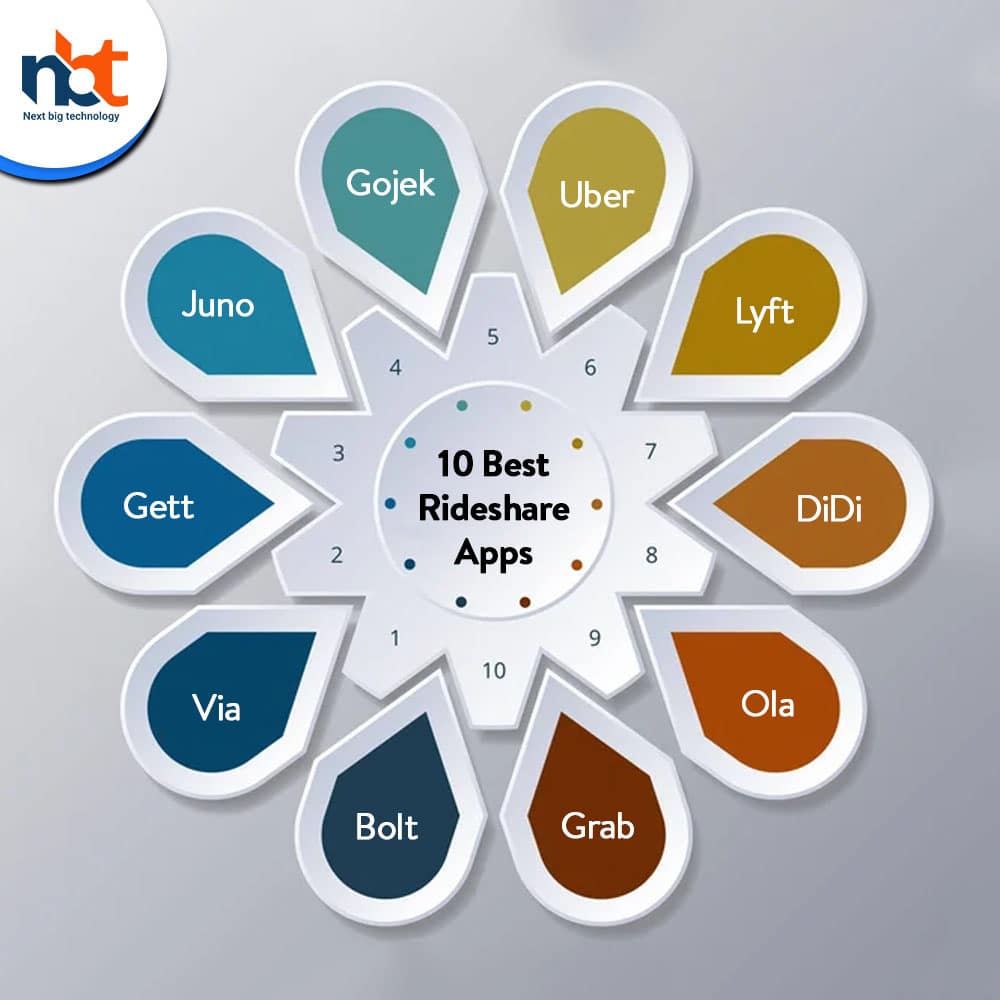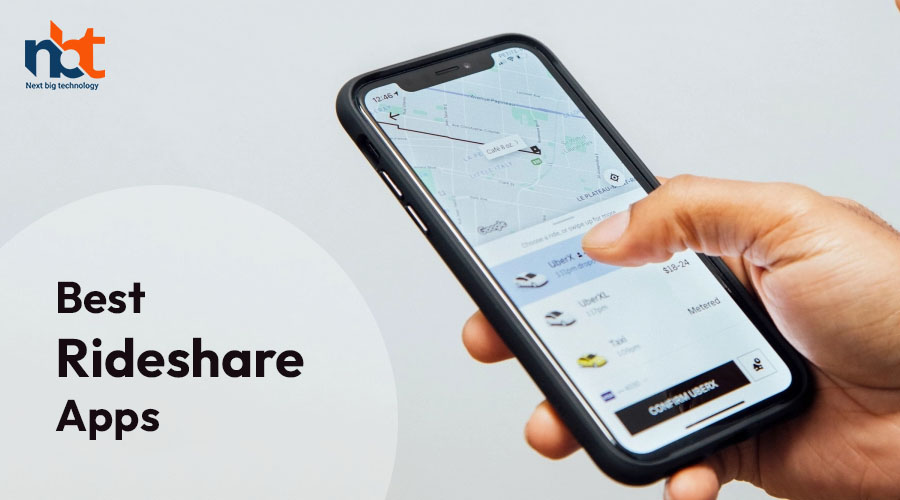Table of Contents
Introduction
The landscape of transportation has undergone a remarkable transformation with the advent of rideshare apps. These innovative platforms have revolutionized how we commute, offering convenience, affordability, and flexibility to millions of riders around the world. Whether you’re looking for a reliable ride to the office, a quick trip to the airport, or an evening out on the town, rideshare apps have become an integral part of modern urban mobility. In this comprehensive guide, we’ll explore the top 10 rideshare apps that have redefined the way we travel, making our journeys not only seamless but also enjoyable.
10 Best Rideshare Apps
| Rideshare App | Ride Options | Pricing Transparency | Driver-Friendly | Safety Features | Additional Services |
|---|---|---|---|---|---|
| Uber | Economy to luxury | Upfront fare estimates | Driver ratings, reviews | Real-time tracking, emergency assistance | Uber Eats, Uber for Business |
| Lyft | Shared rides, luxury | Upfront fare estimates, tipping | Driver ratings, reviews | In-app emergency assistance | – |
| DiDi | Various options | Transparent pricing | Driver verification, training | Real-time safety monitoring, SOS button | – |
| Ola | Autos to electric vehicles | Upfront fare estimates | SOS button, real-time tracking | In-app entertainment, Wi-Fi (select vehicles) | – |
| Grab | Transportation, food delivery | Cashless payments, rewards | Insurance coverage, emergency buttons | Real-time tracking, GrabRewards program | – |
| Bolt | Standard to XL vehicles | Upfront pricing | Transparent earnings, driver-friendly | Real-time tracking | – |
| Via | Shared rides | Transparent pricing | – | Real-time tracking, efficient routing | – |
| Gett | Taxis, luxury cars | Clear pricing | Transparent driver ratings | – | Integration with corporate travel |
| Juno | – | Transparent pricing | Driver-friendly | Secure payment options | – |
| Gojek | Transportation, food delivery, payments | Cashless payments, integrated wallet | Safety features | – | Multiservice platform |
1. Uber:
Undoubtedly the pioneer of the rideshare revolution, Uber has become synonymous with on-demand transportation. With a user-friendly app, a vast network of drivers, and a variety of ride options from economy to luxury, Uber caters to a diverse range of preferences and budgets. Whether you’re traveling solo or with a group, Uber’s extensive coverage ensures you’re just a tap away from your destination.
- Wide range of ride options from economy to luxury
- User-friendly app interface for easy booking and tracking
- Cashless payments with various payment methods
- Real-time GPS tracking and estimated arrival times
- Reliable driver ratings and reviews
- Option to share your trip status with friends or family
- Integration with other services like Uber Eats

2. Lyft:
A close competitor to Uber, Lyft offers a similar range of services with a focus on community and friendliness. Known for its iconic pink mustache logo, Lyft emphasizes its driver-friendly policies and the ability for riders to tip drivers within the app. With options for shared rides, economy, and luxury experiences, Lyft is a favorite among those looking for a personalized touch.
- Various ride options, including shared rides and luxury vehicles
- Transparent pricing with upfront fare estimates
- Option to tip drivers within the app
- Driver and rider safety features, including in-app emergency assistance
- User-friendly interface with easy booking and ride tracking
- Driver ratings and reviews for informed decision-making
3. DiDi:
DiDi, often referred to as the “Uber of China,” has expanded its reach beyond Asia and into several international markets. Boasting a multitude of features such as in-app translation and local payment methods, DiDi is particularly popular among travelers exploring foreign cities. Its focus on safety and customer service has helped it gain a loyal user base worldwide.
- Multilingual app with in-app translation for international travelers
- Range of vehicle options for different preferences and budgets
- Real-time safety monitoring and emergency assistance
- Cashless payments with local payment methods
- Ride scheduling and booking in advance
- Driver verification and continuous training
4. Ola:
Hailing from India, Ola has made its mark as a leading rideshare app not only in its home country but also in several international locations. Ola offers a range of vehicle options, including auto-rickshaws and even electric vehicles, catering to the diverse transportation needs of its users. Ola’s affordable pricing and commitment to innovation have contributed to its widespread success.
- Diverse vehicle options, including autos and electric vehicles
- Transparent pricing with upfront fare estimates
- Multi-city availability with options for both short and long trips
- Ola Share for cost-effective ride-sharing with other passengers
- In-app entertainment and Wi-Fi connectivity in select vehicles
- Focus on safety with SOS button and real-time tracking
5. Grab:
Operating primarily in Southeast Asia, Grab has established itself as a dominant player in the rideshare industry across the region. Beyond transportation, Grab provides additional services such as food delivery and cashless payments. Grab’s focus on localizing its services and understanding the unique needs of each market has contributed to its popularity among both residents and tourists.
- Integrated services including transportation, food delivery, and more
- Cashless payments with GrabPay and local payment options
- GrabRewards loyalty program for discounts and benefits
- Real-time driver tracking and estimated arrival times
- Safety features like emergency buttons and insurance coverage
- Options for both single rides and shared rides
6. Bolt:
Formerly known as Taxify, Bolt has gained traction as a cost-effective alternative to traditional taxis. With an emphasis on transparency, Bolt provides upfront pricing, allowing riders to know the fare before confirming a ride. Bolt’s commitment to driver welfare and environmentally friendly options like electric vehicles make it an appealing choice for conscientious travelers.
- Affordable pricing with upfront fare estimates
- User-friendly app with easy booking and navigation
- Driver-friendly policies and transparent earnings structure
- Range of vehicle options including standard and XL
- Real-time driver tracking and estimated arrival times
- Environmentally friendly options like electric vehicles
7. Via:
Via stands out from the crowd with its shared ride model, which allows passengers traveling in the same direction to share a ride and split the cost. This unique approach not only promotes affordability but also reduces congestion and carbon emissions. Via’s focus on sustainability and efficient routing appeals to environmentally conscious commuters.
- Shared ride model for cost-effective travel with other passengers
- Reduced congestion and emissions through efficient routing
- Easy-to-use app with streamlined booking and scheduling
- Real-time tracking and estimated pick-up and drop-off times
- Option to create and join groups for shared rides
- In-app fare splitting for shared rides
8. Gett:
Gett, originally launched in Israel, has expanded its presence to various countries, including the United States and the United Kingdom. Known for its straightforward pricing and reliability, Gett offers an intuitive app interface and a range of vehicle choices, making it a popular option for both daily commutes and special occasions.
- Clear and straightforward pricing structure
- Variety of vehicle choices including taxis and luxury cars
- User-friendly app interface for easy booking and payments
- Transparent driver ratings and reviews
- Option to book rides in advance or on-demand
- Integration with corporate travel and business profiles
9. Juno:
Juno, acquired by Gett in 2017, aimed to provide a more driver-friendly platform by offering better earnings and the option to own company stock. While Juno’s independent app is no longer available, its commitment to driver satisfaction underscores the importance of fostering positive relationships between drivers and riders within the rideshare ecosystem.
- Driver-friendly platform with better earnings and stock options
- Reliable ride-hailing with transparent pricing
- Personalized driver experience based on driver ratings
- Simple and intuitive app interface for bookings
- Secure payment options and cashless transactions
10. Gojek:
Originating in Indonesia, Gojek has evolved from a rideshare app into a “super app” that offers a wide array of services, including transportation, food delivery, and payment solutions. Gojek’s all-in-one platform has gained immense popularity in Southeast Asia, where it addresses various needs of users in a single, integrated app.
- “Super app” offering multiple services including transportation and food delivery
- Wide range of options for various needs in a single app
- Cashless payments with integrated digital wallet
- Extensive coverage in Southeast Asia
- Driver and rider safety features
- Eco-friendly transportation options
Market Presence of RideShare Apps
| Rideshare App | Market Presence | Primary Operating Regions | International Expansion |
|---|---|---|---|
| Uber | Global | Worldwide | Extensive coverage |
| Lyft | U.S., Canada | North America | Limited international expansion |
| DiDi | Global | Asia, Latin America | Expansion into international markets |
| Ola | India, Australia | India, Australia | Limited international expansion |
| Grab | Southeast Asia | Southeast Asia | Expansion in food delivery and payments |
| Bolt | Global | Europe, Africa | Expansion in multiple regions |
| Via | U.S., Europe | U.S., select cities in Europe | Limited international expansion |
| Gett | Global | U.S., Europe | Expansion in multiple regions |
| Juno | U.S. | New York City | Limited expansion outside New York City |
| Gojek | Southeast Asia | Southeast Asia | Expansion into various services and regions |
FAQ : Rideshare App
Q1: What is a rideshare app?
A1: A rideshare app is a platform that connects riders with drivers for on-demand transportation. Users can book rides through a mobile app, track their driver’s location, and make cashless payments.
Q2: How do rideshare apps work?
A2: Riders use the app to request a ride, and nearby drivers receive the request and accept it. Riders can track their driver’s arrival in real-time, and after the ride, payments are processed through the app.
Q3: Are rideshare apps safe?
A3: Rideshare apps prioritize safety with features like driver background checks, real-time tracking, and SOS buttons. It’s important to verify the driver’s identity before getting into the vehicle and to share your trip details with someone you trust.
Q4: How are fares calculated?
A4: Fares are typically calculated based on factors like distance, time, and surge pricing during high-demand periods. Upfront fare estimates are often provided before confirming a ride.
Q5: Can I schedule rides in advance?
A5: Some rideshare apps offer the option to schedule rides in advance. However, availability may vary based on your location and the specific app.
Q6: What types of vehicles are available?
A6: Rideshare apps offer a variety of vehicle options, ranging from economy cars to luxury vehicles. Some apps also offer shared rides and environmentally friendly options.
Q7: How do I pay for rides?
A7: Most rideshare apps offer cashless payments through the app using credit cards, debit cards, or digital wallets. Some apps also offer local payment methods in specific regions.
Q8: Can I rate and review drivers?
A8: Yes, riders can rate and review drivers after each trip. This feedback helps maintain a high level of service quality within the rideshare community.
Q9: Is tipping allowed?
A9: Many rideshare apps allow riders to tip drivers within the app as a gesture of appreciation for good service.
Q10: Can I use rideshare apps internationally?
A10: Some rideshare apps have expanded internationally and operate in multiple countries. However, availability may vary, and it’s recommended to check app availability in the region you’re traveling to.
Q11: Are there age restrictions for using rideshare apps?
A11: Yes, most rideshare apps require users to be of a certain age (usually 18 or 21) to create an account and use their services.
Q12: What’s the difference between rideshare and traditional taxis?
A12: Rideshare apps often offer more convenient booking, upfront pricing, real-time tracking, and cashless payments. Traditional taxis are street-hailed and may not provide these digital features.
Q13: Are there any discounts or rewards for using rideshare apps?
A13: Some rideshare apps offer promotions, discounts, or loyalty programs for frequent riders. These can include referral bonuses, discounted rides, or other incentives.
Cost of Rideshare Apps
Basic Rideshare App:
-
- Includes essential features like user registration, ride booking, real-time tracking, and payment integration.
- Estimated Cost: $20,000 – $50,000
Rideshare App with Additional Features:
-
- Enhanced user experience with features like in-app messaging, fare estimation, and driver ratings.
- Estimated Cost: $50,000 – $100,000
Advanced Rideshare App:
-
- Advanced features like multiple ride options (economy, luxury), ride scheduling, promotional campaigns, and referral programs.
- Estimated Cost: $100,000 – $200,000
Multi-Platform Rideshare App (iOS, Android, Web):
-
- Development for multiple platforms, ensuring a consistent user experience across devices.
- Estimated Cost: $150,000 – $300,000
Customized Rideshare App:
-
- Custom UI/UX design, advanced admin panel, integration of additional services (e.g., food delivery).
- Estimated Cost: $200,000 – $500,000+
Enterprise-Level Rideshare App:
-
- Advanced features like real-time analytics, AI-driven algorithms for driver matching, and integration with external systems.
- Estimated Cost: $500,000+
Rideshare Apps Pros and Cons
| Rideshare App | Pros | Cons |
|---|---|---|
| Uber | – Extensive global coverage | – Surge pricing during high demand |
| Lyft | – Friendly and community-oriented | – Limited international availability |
| DiDi | – Multilingual app for international travelers | – Limited presence in some regions |
| Ola | – Eco-friendly options with electric vehicles | – Limited availability outside India and Australia |
| Grab | – Multiservice platform with various offerings | – Available primarily in Southeast Asia |
| Bolt | – Focus on affordable rides and upfront pricing | – Limited availability in certain regions |
| Via | – Cost-effective shared rides with efficient routing | – Limited availability in select cities |
| Gett | – Transparent pricing and clear fare structure | – Available in limited regions |
| Juno | – Driver-friendly approach and stock options | – Limited expansion outside New York City |
| Gojek | – Multiservice “super app” for diverse needs | – Available primarily in Southeast Asia |
How To Build A Rideshare App?
1. Market Research and Idea Validation:
- Research the rideshare industry to understand trends, competition, and user needs.
- Identify unique features or improvements you can bring to the market.
2. Define App Features and Functionality:
- Determine the core features like user registration, ride booking, real-time tracking, payments, and driver matching.
- Consider additional features like in-app messaging, promotions, referral programs, and driver ratings.
3. Choose the Development Approach:
- Decide whether you’ll develop the app in-house or hire a development team or agency.
- Choose the technology stack (programming languages, frameworks, databases) for app development.
4. Design User Interface and User Experience (UI/UX):
- Create wireframes and mockups of the app’s screens and user flows.
- Design an intuitive and user-friendly interface that ensures a seamless experience.
5. Development:
- Develop the front-end (user interface) and back-end (server-side) components of the app.
- Implement features like ride booking, real-time tracking, payments, and driver matching algorithms.
- Integrate APIs for maps, payment gateways, and other necessary services.
6. Testing:
- Conduct thorough testing to ensure the app functions correctly, is secure, and offers a smooth user experience.
- Test the app across different devices, operating systems, and network conditions.
7. Launch and Deployment:
- Deploy the app to app stores (such as Apple App Store and Google Play Store) after testing is complete.
- Set up accounts, gather necessary assets, and follow store guidelines for a successful launch.
8. Marketing and Promotion:
- Develop a marketing strategy to promote your app to potential users.
- Utilize social media, influencer collaborations, and other marketing channels to generate interest.
9. Monitoring and Updates:
- Monitor the app’s performance, user feedback, and ratings.
- Regularly update the app to fix bugs, add new features, and improve user experience.
10. Legal and Regulatory Compliance:
- Ensure your app complies with local transportation regulations, data privacy laws, and payment security standards.
11. Customer Support and Feedback:
- Set up customer support channels to address user queries, concerns, and feedback.
- Use user feedback to continuously improve the app’s features and functionality.
Remember that building a rideshare app is a complex process that requires technical expertise, design skills, and thorough planning. If you’re not familiar with app development, consider hiring a professional development team or partnering with an app development agency to ensure a successful and high-quality product.
Conclusion
The rise of rideshare apps has transformed the way we navigate our cities and reach our destinations. With a diverse range of platforms catering to different preferences, budgets, and regions, riders are spoilt for choice when it comes to selecting the best rideshare app for their needs. Whether you’re seeking affordability, luxury, sustainability, or community-driven experiences, the 10 best rideshare apps listed above offer a comprehensive array of options that have redefined urban transportation.
As technology continues to advance and the world of transportation evolves, rideshare apps are likely to play an increasingly pivotal role in our daily lives. Whether you’re a seasoned rideshare user or new to the concept, these apps open doors to a convenient, efficient, and enjoyable way of getting around, ensuring that every journey is as memorable as the destination itself.










